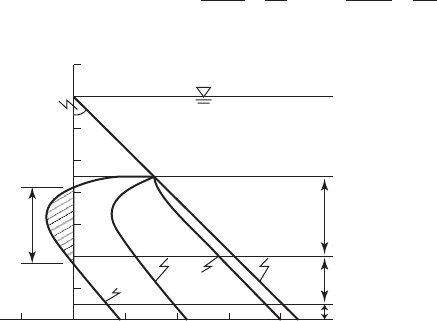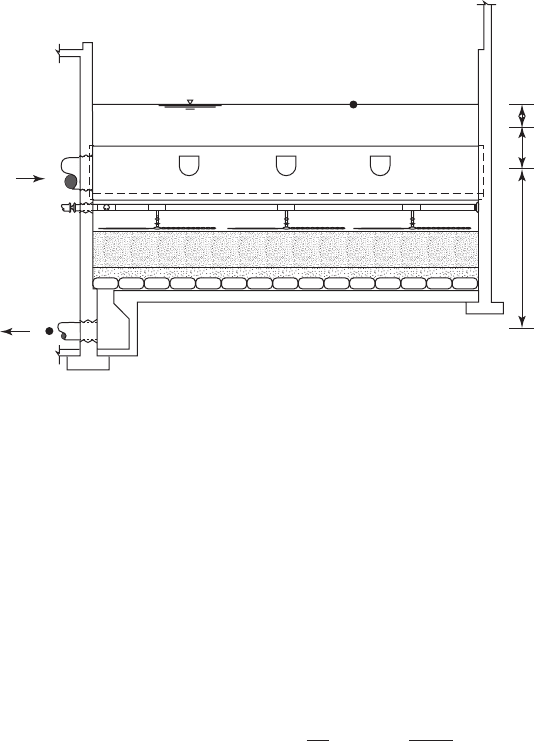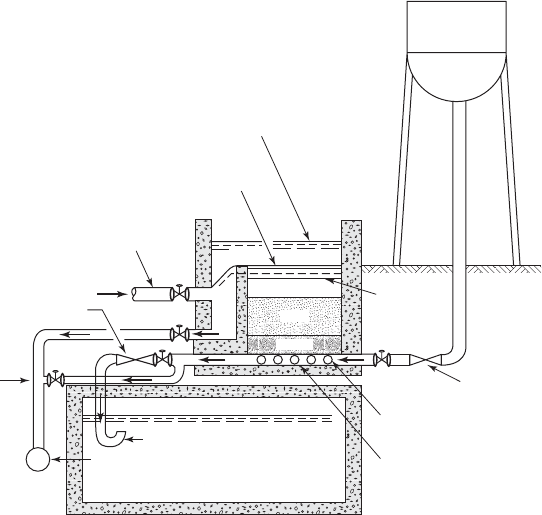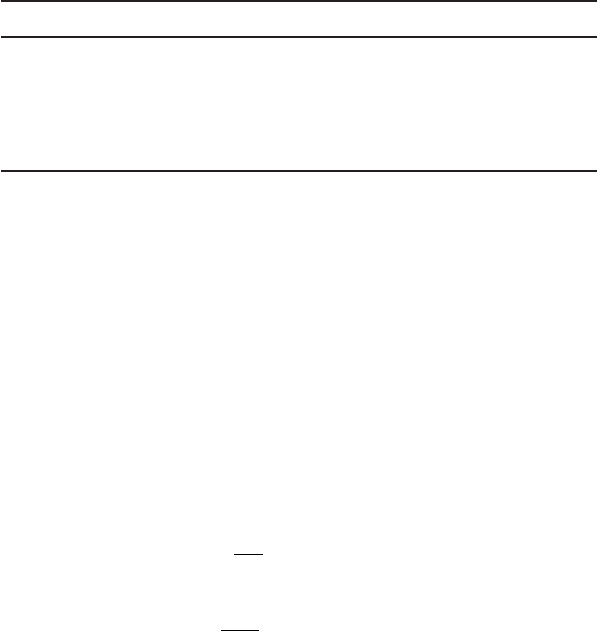Water and Wastewater Engineering
Подождите немного. Документ загружается.


11-36 WATER AND WASTEWATER ENGINEERING
without good maintenance they may overshoot the set point and “hunt” for the correct position, or
possibly attempt to balance the flow in steps that result in surges to the filters that remain on line.
In the weir splitting system, water flows in through a common channel and is split equally to
all operating filters by the weir. This system is the sim
plest method for splitting the flow, and rate
changes are made gradually without the hunting of control valves.
In declining rate filtration no active control or apportionment is used. Each filter receives a
different flow rate depending on the accumulated headloss. The cleanest filters receive the great-
est flow, and the flow through each filter declines as solids a
ccumulate. The advantage of this
system is that it can be constructed without instrumentation or flow control. The disadvantages
are that the operators have no indication of the flow rate or headloss, there is no method to control
the filtration rate, and the rate at the beginning of filtration after cleaning may exceed the design
filtration rate resulting in turbidity breakthrough.
Headloss Accommodation
The hydraulic gradient through the filter at various tim es during a filter run is illustrated in
Figure 11-15 . Negative head (less than atmos pheric pressure) develops in a filter when the
summation of headlosses from the media surface downward exceeds the depth of water to that
point. It is not uncommon to have a meter or more of headlo
ss in the upper 15 cm of a dirty
sand filter bed (Cleasby, 1972). When shallow water operating depths are provided, negative
head develops a short distance into the media. The negative pressure may cause bubbles of
dissolved oxygen and nitrogen to come out of solution. If these bubbles are trapped in the bed
(a phenomenon
called air binding ), they red uce the effective filtering area. This increases the
filtration rate through the remaining filter area, which results in a more rapid turbidity break-
through than otherwise would occur. In addition, the headloss rises dramatically.
The depth of water required to prevent a negative pressu re in the filter can be estimated by
solving Bernou
lli’s equation for the headloss between the water surface on the filter and the cen-
terline of the effluent pipe. Using the notation in Figure 11-16 :
() ()vp
z
vp
zh
L
1
2
1
1
2
2
2
2
22ggg
(11-21)
0.5
Near end
of filter run
45°
Zone of
negative
pressure
Near middle
of filter run
Clean filter
at design rate
Static pressure
(no flow)
Water surface
Coal
Sand
Under drain
1.0
Pressure, m (water gauge)
Depth from water surface
1.5 2.00
0.5
FIGURE 11-15
Pressure development within filter bed during filtration.

GRANULAR FILTRATION 11-37
where v
1
, v
2
velocities at points 1 and 2, m/s
p
1
, p
2
pressures at points 1 and 2, kPa
z
1
, z
2
elevation heads at points 1 and 2, m
g acceleration due to gravity, m/s
2
specific weight of water, kN/m
3
h
L
headloss through filter media, and underdrain system, m
If relative pressure is used, p
1
0. The velocity at the surface of the water in the filter box
may be assumed to be zero. The datum is selected so that z
2
0. Equation 11-21 may then be
reduced to
p
z
v
g
h
L
2
1
2
2
2
()
(11-22)
The depth of sand, gravel, underdrain, and the water above the media is equal to z
1
. The velocity
in the effluent pipe is v
2
. The depth of water above the filter media is selected to maintain a posi-
tive value for p
2
/ .
It is natural for designers to make the filter box as shallow as possible. Deeper boxes are
more expensive than shallow ones. Early in the 20th century it was common to design for media
submergence of 1.2 to 1.5 m for rapid sand filters. A majority of these plants (up to 80 percent)
reported air binding (Huds
on, 1981).
The available headloss for gravity filters is generally designed to be 2.5 to 3 m. Kawamura
(2000) recommends that a minimum depth of water above the filter bed of 1.8 m be provided and
that a preferred depth is 2.4 m. He also notes that the turbidity of gravity filters often begins to
increase when the net headloss is over 1.8 m. Consequently, the filter m
ust be backwashed even
though the headloss available may be 2.4 m or more.
E xample 11-8 illustrates the headloss calculation.
1
2
Effluent
Influent
v
2
2
/ 2g
h
L
p
2
/␥
FIGURE 11-16
S chematic of granular filter during filtration. The Notation for Equation 11-22 is shown
at right.

11-38 WATER AND WASTEWATER ENGINEERING
Example 11-8. Determine the depth of the filter box for Ottawa Island’s sand filter. Use the
clean bed headloss from Example 11-2 , and the velocity headloss and the media and underdrain
depths from Example 11-7 . Assume the minimum depth of water above the filter bed is 2.4 m.
Solution:
a . Calculate z
1
using the assumed water depth and other depths from Example 11-7 .
z
1
water depth depth of sand gravel and,,uunderdrain
mmmmmz
1
24 06 03 0 336.. ...
b. The velocity headloss from Example 11-7 is
v
22
2
2
18
2981
0165 017
g
m/s
m/s
or m
()
()
.
.
..
c. Calculate p
2
/ at the beginning of a filter run using the clean bed headloss calculated in
E xample 11-2 .
p
2
36 017 076 267 27
.. . ..mmm or
m
d. Estimate the maximum allowable headloss.
p
2
36 017 343
.. .mmh mh
LL
Thus, the maximum headloss that will cause a negative pressure in the filter is one that
is 3.43 m.
e. The filter box depth is estimated as
D
box
depth of water depth of media depth of underdrain
factor of safety freeboard
A ssuming a factor of safety of 0.6 m and a freeboard depth of 0.6 m
D
box
mmmmmm24 09 03 06 06 48......
Comments:
1 . The elevation of the maximum water level in the filter box governs the hydraulic profile
of the upstream processes in the plant. This, in turn, has a significant impact on the cost
of the plant. This cost, as well as the cost of the filter itself, favor the design of shallower
rather than deeper filter boxes.
2. The use of low profile drains and those that do not need gravel allow for the
design of a
shallower filter box.
3. Though more expensive, a d eeper filter box provides for future expansion to deep bed
monomedium.
4. The technique used here for establishing the depth of the filter box is conservative. Monk
(1984) provides a detailed method for optimizing the depth of the filter box.

GRANULAR FILTRATION 11-39
In addition to providing for a minimum depth of water, operational control must be provided to
accommodate the increase in headloss during operation. Three methods are used to accommodate
the increase in headloss during filtration: (1) maintaining a constant head in the filter effluent by the
use of a modulating control valve, (2) maintaining a constant head in the filter effluent and
allowing
the water level to rise, and (3) maintaining a constant headloss and allowing the filtration rate to
decline. These are discussed in detail by Castro et al. (2005), Monk (1987), and MWH (2005).
Some Important Appurtenances
Many features of the filter design are beyond the scope of this text, but a few are sufficiently
noteworthy to identify them here.
A s noted in F igure 11-2 the turbidity levels rise immediately after filter backwash and then
drop off as the filter begins to clog. When this rise is averaged over the filter run, the change
in turbidity is sm
all. However, outbreaks of Giardiasis and Cryptosporidiosis caused by proto-
zoan cysts that are very resistant to chlorine disinfection make even this “small” perturbation a
potential health hazard (Hibler et al., 1987; Kramer et al., 1996). The design and operating solu-
tion is to provide for a “filter-to-waste” period immediately after backwashing. A diagram s
how-
ing a method for the design to implement filter to waste is shown in Figure 11-17 .
Because of outbreaks of Giardiasis and Cryptosporidiosis, filtration practice now includes a
provision for monitoring the effluent turbidity from eac h filter. It is us ed to guide the length of
Lateral drain
Washwater rate
controller
Bottom of
washwater
trough
Washwater
storage tank
Water level
while filtering
Water level
while washing
From coagulation
clarification basin
Filter rate
controller
Filter to
waste valve
Washwater
drain
E
Main drain
Seal
A
B
C
D
Filtered water
storage tank
Sand
Gravel
FIGURE 11-17
Diagrammatic section of a rapid sand gravity filter. A, B, C, D, and E are valves that may be
hydraulically or pneumatically actuated. Valve D permits wasting filtered water. The seal in the
effluent pipe keeps the pipe full at all times so that the rate controller will function.

11-40 WATER AND WASTEWATER ENGINEERING
time for filter effluent to be diverted to waste and to detect the onset of breakthrough of turbidity
that signals the end of a filter run.
Many very small particles can exist in the water with turbidity less than 1 NTU. This implies
that asbestos fibers, bacteria, viruses, and cysts may be passing through even with very low tu
r-
bidities. Particle counters are used to detect these small particles and are recommended in con-
junction with turbidimeters to address this issue (Cleasby and Logsdon, 1999).
Design Criteria
Along with Tables 11-1 , 11-3 , 11-4 , and 11-5 , Tables 11-6 through 11-13 provide a summary of
the design guidance presented in this section.
Source: Adapted from MWH, 2005.
TABLE 11-6
Pretreatment conditions for different operating modes
Operating mode Pretreatment conditions
Conventional filtration Coagulation with alum or ferric chloride and
polymer followed by flocculation and
sedimentation. Can treat turbidities up to
1,000 NTU.
Direct filtration Coagulation with alum or ferric chloride and
polymer followed by flocculation, but not
sedimentation. Limited to raw water turbidities less
than 15
NTU.
In-line filtration Coagulation with alum or ferric chloride and
polymer. Flocculation is incidental. Sedimentation
is not provided. Limited to turbidities less than 10
NTU.
TABLE 11-7
Recommended dimensions of ordinary gravity rapid filters
Parameter
Reported
range of values Comment
Area of filter 25–100 m
2
Very large plant maximum is 200 m
2
Width of cell 6 m For “Off-the-shelf” troughs
L:W ratio 2:1 to 4:1
Depth 4–8 m Provide space for underdrain
Depth of water 1.8 m
Gullet
Width 0.4–2 m
Depth Varies from top of media to
bottom of underdrain
Measured from the bottom of wash
trough
Sources: Castro et al., 2005; GLUMRB, 2003; Kawamura, 2000.

GRANULAR FILTRATION 11-41
Parameter
Reported
range
GLUMRB
recommendation Recommended
Sand only
Effective size 0.35– 0.7 mm 0.45–0.55 mm
Uniformity coefficient 1.3–1.8 1.65
Shape factor (f)
0.7– 0.95
Porosity 0.4– 0.47
Specific gravity 2.65
Depth of medium 0.6– 0.75 m 0.6 m and .76 m
Filtration rate 5–12 m/h 7.5
m/h
Backwash rate 30–60 m/h 37 m/h
Backwash duration
a
10–20 min 15 min
Surface wash rate
Revolving arms 1.2–1.8 m/h 1.2m/h
Fixed arms 4.9–10 m/h 4.9 m/h
Air scour Staged or special baffle
Anthracite coal only
Effective size 0.70– 0.75 mm 0.45–0.55 mm
Uniformity coefficient 1.3–1.8 1.65
Shape factor (f)
0.46–0.73
Specific gravity 1.45–1.75
Porosit
y 0.53–0.60
Depth of medium 0.6–0.75 m
Filtration rate 5–12 m/h 7.5 m/h
Backwash rate 37– 45 m/h 24 m/h
Backwash duration
a
10–20 min 15 min
Surface wash rate
Revolving arms 1.2–1.8 m/h 1.2 m/h
Fixed arms 4.9–10 m/h 4.9 m/h
Underdrain
Pipe lateral Yes
BlockYes
Air scourNo
Air scour Staged or special baffle
TABLE 11-8
Design criteria for single-medium filters
a
A ctual off-line time will be 30 min because of the time required to drain the filter and gradually come up to the
full backwash rate. An additional 30–40 minutes off-line is required for “filter-to-waste” to clear the bed of wash
water and dislodged turbidity.
Sources: Castro et al., 2005; Cleasby and Log
sdon, 1999; GLUMRB, 2003; Kawamura, 2000; MWH, 2005;
Reynolds and Richardson, 1996.

11-42 WATER AND WASTEWATER ENGINEERING
TABLE 11-9
Design criteria for dual-media filters
Parameter
Reported
range
GLUMRB
recommendation Recommended
Anthracite coal on top
Effective size 0.9–1.4 mm 0.8–1.2 mm
Uniformity coefficient 1.3–1.8 1.85
Shape factor (f)
0.46–0.73
Porosity 0.53–0.60
Specific gravity 1.45–1.75
Depth of medium 0.4–0.6 m
Sand on bottom
Effective size 0.35–0.7 mm 0.45–0.55 mm
Uniformity coeffic
ient 1.3–1.8 1.65
Shape factor (f)
0.7–0.95
Porosity 0.4–0.47
Specific gravity 2.65
Depth of medium 0.3–0.75 m 0.6 m and 0.76 m
Filtration rate 7–20 m/h 15 m/h
Backwash rate 30–60 m/h 24 m/h
Backwash duration
a
10–20 min 15 min
Surface wash rate
Revolving arms 1.2–1.8 m/h 1.2 m/h
Fixed arms 4.9–10 m/h 4.9 m/h
Underdrain
Pipe lateral Yes
BlockYes
Air scour No—if total depth of medium
0.75 m
Air scour 0.6–1.5 m
3
/min · m
2
if total
medium depth 1 m
a
A ctual off-line time will be 30 min because of the time required to drain the filter and gradually come up to the full
backwash rate. An additional 30–40 minutes off-line is required for “filter-to-waste” to clear the bed of wash water and
dislodged turbidity. If air scour is provided, the time will be even longer beca
use of the necessity of sequencing the air scour
and wash water.
Sources: Castro et al., 2005; Cleasby and Logsdon, 1999; GLUMRB, 2003; Kawamura, 2000; MWH, 2005; Reynolds and
Richardson, 1996.

GRANULAR FILTRATION 11-43
Parameter
Reported
range Recommended
Anthracite coal on top
Effective size 0.9–1.4 mm
Uniformity coefficient 1.4–1.75
Shape factor (f)
0.46–0.73
Porosity 0.53–0.60
Specific gravity 1.45–1.75
Depth of medium 0.4–0.5 m
Sand in middle
Effective size 0.45–0.55 mm
Uniformity coefficient 1.4–1.65
Shape factor (f)
0.7–0.95
Porosity 0.4–0.47
Spec
ific gravity 2.65
Depth of medium 0.15–0.3 m
Garnet on bottom
Effective size 0.20–0.35 mm
Uniformity coefficient 1.2–2.0
Shape factor (f)
0.6
Specific gravity 3.6–4.2
Depth of medium 0.075–0.15 m
Filtration rate 10–25 m/h 15 m/h
Backwash rate 37–45 m/h
Backwash duration
a
10–20 min 15 min
Surface wash rate
Revolving arms 1.2–1.8 m/h
Fixed arms 4.9–10 m/h
Underdrain
Pipe lateral Yes
BlockYes
Air scour No—if total depth of medium
0.75 m
Air scour 0.6–1.5 m
3
/min · m
2
if total medium
depth 1 m
TABLE 11-10
Design criteria for tri-media filters
a
Actual off -line time will be 30 min because of the time required to drain the filter and gradually come
up to the full backwash rate. An additional 30–40 minutes off-line is required for “filter-to-waste” to
clear the bed of wash water and dislodged turbidity. If air scour is provided, the time will be even longer
becau
se of the necessity of sequencing the air scour and wash water.
Sources: Castro et al., 2005; Cleasby and Logsdon, 1999; Kawamura, 2000; MWH, 2005; Reynolds and
Richardson, 1996.

11-44 WATER AND WASTEWATER ENGINEERING
Parameter
Reported range
of values Recommended
Anthracite coal
Effective size 0.9–1.0 mm
Uniformity coefficient 1.4–1.7
Shape factor (f)
0.46–0.73
Specific gravity 1.45–1.75
Porosity 0.53–0.60
Depth of medium 0.9–1.8 m
Filtration rate 10–25 m/h 15 m/h
Backwash rate 37–45 m/h
Backwash duration
a
15 min
Surface wash rate
Revolving arms 1.2–1.8 m/h 1.2 m/h
Fixed arms 4.9–10 m/h 4.9 m/h
Underdrain
Pipe lateral No
BlockYes
Air scourYes
Air scour 0.6–1.5 m
3
/min · m
2
TABLE 11-11
Design criteria for deep-bed monomedium filters
a
A ctual off-line time will be 30 min because of the time required to drain the filter and
gradually come up to the full backwash rate. An additional 30–40 minutes off-line is required
for “filter-to-waste” to clear the bed of wash water and dislodged turbidity. If air scour is provided,
the time will be even longer be
cause of the necessity of sequencing the air scour and wash
water.
Sources: Castro et al. 2005; Cleasby and Logsdon, 1999; Kawamura, 2000; MWH, 2005; Reynolds
and Richardson, 1996.
Parameter Criterion
Length 6m
Interval Particle travel distance 1 m
Height to weir edge
Sand filter Expansion depth of trough 0.15 to 0.3 m
Anthracite 1.1–1.2 m
Freeboard5 cm
Installation Weirs level
TABLE 11-12
Wash trough design criteria
Sources: Castro et al., 2005; Cleasby and Logsdon, 1999; GLUMRB, 2003.

GRANULAR FILTRATION 11-45
TABLE 11-13
Approximate flow velocities for filter channels and piping
Channel or pipe Velocity, m/s
Influent conduit carrying flocculated water 0.3–0.6
Effluent conduit carrying filtered water 0.9–1.8
Backwash water conduit carrying clean wash water 2.4–3.5
Backwash water conduit carrying used wash water 1.2–2.4
Filter-to-waste connections3.6–4.6
11-7 OPERATION AND MAINTENANCE
Under steady-state conditions, the operation and maintenance of the filter system is routine. Rapid
sand filters following coagulation/flocculation are generally operated with filter run lengths be-
tween 12 and 96 hours with typical runs of about 24 hours. Some plants operate with longer
cycles. Longer runs may make cleaning difficult beca
use of compaction of the particulate matter
(Cleasby and Logsdon, 1999; Castro et al., 2005). Baumann (1978) recommends that at peak
solids and flow, run times should be greater than 15 hours and less than 24 hou rs. In the East
Lansing water treatment plant, with softening floc, run times with a 2 NTU influent to the filter
are limited to about 60 hours. With a m ore normal 0.
5 NTU influent, filter runs are terminated
at 120 hours to allow a 24-hour “float” for operational expediency. There is a general relation-
ship between the influent particulate concentration, the filtration rate, and the filter run. It can be
expressed as follows (Reynolds and Richards, 1996):
v
v
vv
a
a
aa
1
2
12
()runtimeat runtimeat
C
C
CC
in
in
in in
runtimeat runtimeat
2
1
12
()
where v
a 1
, v
a 2
filtration rates 1 and 2, m/h
C
in
1
, C
in 2
influent particulate concentration, NTU
With changing raw water quality, equipment failure, power outages, and maintenance activi-
ties, rigorous attention to the filter system and upstream process is required. Three indicators are
used in evaluating the performance of the filter: filtered water turbidity, length of the filter run,
and the ratio of the volume of bac
kwash water to the volume of filtered water.
After backwash, when steady-state is achieved, the turbidity should always be less than 0.1
NTU. Deviation from this level is an indication of need for ad justment of the coagulation/floc-
culation/settling system.
Shorter filter runs may imply one or more of several problems. Exam
ples include air binding,
accumulation of mud balls, and poorly settling floc.
Increases in the ratio of wash water to filtered water imply difficulty in cleaning the filter.
This can result from deterioration (plugging) of the surface wash system or maldistribution of the
backwash water.
These and many other i
ssues are addressed in detail in Kawamura (2000) and the American
Water Works Association’s Filter Maintenance and Operations Guidance Manual (2002).
